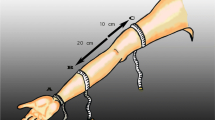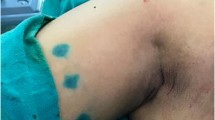Abstract
Purpose
To prospectively assess the efficacy of the lymphatic microsurgical preventive healing approach (LYMPHA) to prevent lymphedema after axillary dissection (AD) for breast cancer treatment.
Methods
Among 49 consecutive women referred from March 2008 to September 2009 to undergo complete AD, 46 were randomly divided in 2 groups. Twenty-three underwent the LYMPHA technique for the prevention of arm lymphedema. The other 23 patients had no preventive surgical approach (control group). The LYMPHA procedure consisted of performing lymphatic-venous anastomoses (LVA) at the time of AD. All patients underwent preoperative lymphoscintigraphy (LS). Patients were followed up clinically at 1, 3, 6, 12, and 18 months by volumetry. Postoperatively, LS was performed after 18 months in 41 patients (21 treatment group and 20 control group). Arm volume and LS alterations were assessed.
Results
Lymphedema appeared in 1 patient in the treatment group 6 months after surgery (4.34%). In the control group, lymphedema occurred in 7 patients (30.43%). No statistically significant differences in the arm volume were observed in the treatment group during follow-up, while the arm volume in the control group showed a significant increase after 1, 3, and 6 months from operation. There was significant difference between the 2 groups in the volume changes with respect to baseline after 1, 3, 6, 12, and 18 months after surgery (every timing P value < 0.01).
Conclusions
LYMPHA represents a valid technique for primary prevention of secondary arm lymphedema with no risk of leaving undetected malignant disease in the axilla.



Similar content being viewed by others
References
Thompson S, Korourian R, Henry-Tillman R, et al. Axillary reverse mapping (ARM): a new concept to identify and enhance lymphatic preservation. Ann Surg Oncol. 2007;14:1890–5.
Bennett Britton TM, Buczacki SJ, Turner CL, Vowler SL, Pain SJ, Purushotham AD. Venous changes and lymphoedema 4 years after axillary surgery for breast cancer. Br J Surg. 2007;94:833–4.
Soran A, D’Angelo G, Begovic M, et al. Breast cancer–related lymphedema—what are the significant predictors and how they affect the severity of lymphedema? Breast J. 2006;12:536–43.
Purushotham AD, Bennett Britton TM, Klevesath MB, et al. Lymph node status and breast cancer–related lymphedema. Ann Surg. 2007;246:42–5.
Boccardo F, Casabona F, De Cian F, et al. Lymphedema microsurgical preventive healing approach: a new technique for primary prevention of arm lymphedema after mastectomy. Ann Surg Oncol. 2009;16:703–8.
Campisi C, Boccardo F. Microsurgical techniques for lymphedema treatment: derivative lymphatic-venous microsurgery. World J Surg. 2004;28:609–13.
Sitzia J. Volume measurement in lymphedema treatment: examination of formulae. Eur J Cancer Care. 1995;4:11–6.
Casley-Smith JR. Measuring and representing peripheral oedema and its alterations. Lymphology. 1994;27:56–70.
Ververs JM, Roumen RM, Vingerhoets AJ, et al. Risk, severity and predictors of physical and psychological morbidity after axillary lymph node dissection for breast cancer. Eur J Cancer. 2001;37:991–9.
Ponzone R, Mininanni P, Cassina E, Sismondi P. Axillary reverse mapping in breast cancer: can we spare what we find? Ann Surg Oncol. 2008;15:390–1.
Sener SF, Winchester DJ, Martz CH, et al. Lymphedema after sentinel lymphadenectomy for breast carcinoma. Cancer. 2001;92:748–52.
Wilke LG, McCall LM, Posther KE, et al. Surgical complications associated with sentinel lymph node biopsy: results from a prospective international cooperative group trial. Ann Surg Oncol. 2006;13:491–500.
Sakorafas GH, Peros G, Cataliotti L, et al. Lymphedema following axillary lymph node dissection for breast cancer. Surg Oncol. 2006;15:153–65.
Nos C, Lesieur B, Clough KB, Lecuru F. Blue dye injection in the arm in order to conserve the lymphatic drainage of the arm in breast cancer patients requiring an axillary dissection. Ann Surg Oncol. 2007;14:2490–6.
Kleinhans E, Baumeister RG, Hanh D, et al. Evaluation of transport kinetics in lymphoscintigraphy: follow-up study in patients with transplanted lymphatic vessels. Eur J Nucl Med. 1985;10:349–52.
Cambria RA, Gloviczki P, Naessens JM, et al. Noninvasive evaluation of the lymphatic system with lymphoscintigraphy: a prospective, semiquantitative analysis in 386 extremities. J Vasc Surg. 1993;18:773–82.
Author information
Authors and Affiliations
Corresponding author
Rights and permissions
About this article
Cite this article
Boccardo, F.M., Casabona, F., Friedman, D. et al. Surgical Prevention of Arm Lymphedema After Breast Cancer Treatment. Ann Surg Oncol 18, 2500–2505 (2011). https://doi.org/10.1245/s10434-011-1624-4
Received:
Published:
Issue Date:
DOI: https://doi.org/10.1245/s10434-011-1624-4




